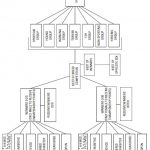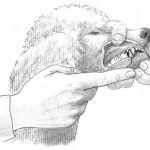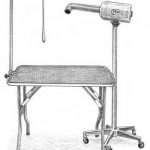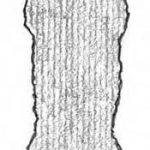Instilling Good Manners in Your Poodle
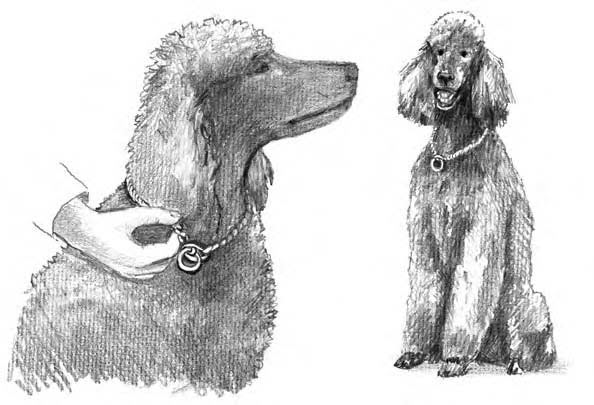
In This Chapter
- Beginning with basic training principles
- Working with a collar and lead
- Teaching basic commands to your Poodle
- Conquering common behavior problems
- Acquiring the help of professionals
Dogs are pack animals, which means, in report-card language, that they “play well with others.” Dogs don’t function well as loners; they do well with structure, routine, and rules. You want your Poodle to be a socialite, but you don’t want her to be the boss or to annoy your acquaintances. An untrained dog may be an unhappy dog, because she doesn’t know what you expect of her. Your Poodle doesn’t have to be a champion obedience dog, but she should have good manners — for your sake and for hers.
Getting a Grip on Some Disciplinary Basics
– Have your equipment handy. A plain buckle collar and a lead are all the equipment you need, and for some training, you can work without them. (I discuss collars and leads in the next section.) If you decide to train with food rewards, have a good supply of treats on hand, and keep them small. Your objective is training, not overfeeding.
– Keep your training sessions short. You can make more progress if you train four times a day at five minutes per session than if you hold one 20-minute training session.
– Have a release word that tells your dog she can stop acting on your command. Make the release word short, and say it happily. Many owners use “okay.” No matter what word you choose, be consistent. Don’t say “okay” today and “good job” tomorrow.
– Try not to laugh at mistakes. Poodles are very intelligent, and they have good senses of humor. They seem to enjoy making people laugh; therefore, if you laugh at your Poodle during training, you’ll find that she’s likely to repeat whatever behavior made you laugh.
– Be flexible with your training methods. Not every training method works for every dog every time (which is why I list many in this chapter). Be consistent with your commands and methods, but if a technique isn’t working, don’t be afraid to try something different.
– Never punish your dog for obeying. You may be furious that she ran away from you, but you need to praise her if she obeyed your “stay” command. Poodles aren’t stupid. They won’t obey any command that gets them punished.
– No losing your temper, and no hitting, ever. Don’t scream uncontrollably or hit or kick your dog. If you get frustrated, take a break. Go somewhere far away from your Poodle. Take a walk. Count to 100. Meditate. Distract yourself until you can approach your dog calmly.
– Always end on a positive note. For example, if your Poodle knows the “sit” command and always follows it promptly, but she hasn’t quite mastered “down,” end your session with a sit.
Handling a Collar and Lead
Collaring your Poodle
Beginning with buckle collars
Remember
You should start with a simple buckle collar for your Poodle puppy. The collar should be tight enough that your dog can’t paw it off over her head, but not so tight that it chokes her or rubs a sore on her neck. Here’s a good test: You should be able to slide two fingers between her throat and the collar. And remember, your puppy is growing all the time, so a collar that fit her perfectly last week may be getting too tight this week. You can leave a buckle collar on your dog all the time, so make sure she’s comfortable!
Tip
If your Poodle always wears a buckle collar, think about adding a small bell or two — especially if you have a Toy or a Miniature Poodle (see Chapter Socializing Your Poodle for more on the distinctions). Small dogs have to worry about people stepping on them or tripping over them. A bell announcing your dog’s presence may help reduce injury risk.
Fitting other types of collars
Warning!
On the negative side, that extra loop can easily catch on something, or your Poodle could get her paw or jaw tangled in the loop and injure herself. You should use the martingale collar only when you’re with your dog on a walk or during a training session. Take it off afterward.
Warning!
If you leave a training collar on your Poodle, and the ring on the end of the collar catches onto something, your dog could die. Never tie your dog outside with a training collar, and never leave your dog unattended while she’s wearing a training collar.
Gaining control with harnesses or halters
Tip
At first, dogs fight head halters. The secret to faster acceptance is to keep your Poodle’s head up as she tries to paw off the halter. Try not to let her succeed; if she knows she can get it off, it will take longer to convince her to leave it alone.
Warning!
Head halters come with detailed instructions on their use, which should be followed carefully. Head halters should never be pulled or jerked with the leash, as this action can jerk the dog’s head around and cause serious neck injury. An injury can also occur if the dog makes a sudden lunge that causes her head to be pulled back or to the side. It’s best to learn the use of a head halter under the direction of an experienced trainer.
Leading on
1. Start by attaching a lightweight, short lead to your puppy’s collar (collars come with a ring just for this purpose).
Many show leads are ideal for puppies, because they’re lightweight and shorter than a regular lead.
2. Let your puppy drag the lead until she gets used to it.
Remember
Always supervise when the lead is attached to your puppy’s collar. You don’t want it to catch on an object and panic your puppy.
3. After your puppy gets used to dragging the lead, pick the lead up and walk with her.
The desired position when you walk a dog is to have the dog on your left side, but at this point, don’t worry about that. You want the dog walking on a slack lead and at this point, that’s all.
4. If your puppy keeps getting distracted, encourage her to walk with you by slapping your leg and calling her.
Tip
Having a treat or two on hand is also a good idea. Here’s a tip to teach your Poodle not to pull or to follow you when you want to change directions: Every time she wants to go somewhere you don’t, stop. Just stand still. She’ll likely look back to see what’s going on, and then you can start walking again. Or, after you have her attention, you can turn and head in the direction you want.
Training Your Poodle with Basic Commands
Come!
– Always praise your Poodle for coming to you.
– Never call your Poodle to you for punishment or for any activity she may find unpleasant, like nail clipping. For these situations, go and get her.
– Never call your Poodle if you can’t enforce the command. For example, if your dog is bounding across the yard after a squirrel, don’t start hollering “Come!” Doing so just teaches her that she doesn’t have to obey.
Tempting with treats
1. Start with your dog on lead.
You can use a long rope as the training advances, so you always have the option of reeling your dog in. That way, she learns that even at a distance, she must obey the command.
2. Train close up at first so your Poodle can see and smell the treat.
Don’t pull her in with the lead unless it’s absolutely necessary.
3. When your Poodle reaches you, take hold of her collar before you give her the treat.
If you really need to catch your Poodle, you don’t want her to run in, snatch the treat, and take off again, so include holding the collar as part of the deal. If you want to, you can let go and allow her to go back to whatever she was doing before you called her. Mix the training up so that the command to come doesn’t always mean that playtime is over.
Tip
If your dog is less than enthusiastic over the treat you’re using, switch to something more tempting, like a ball or a squeaky toy. Use whatever it takes to get your Poodle running to you when you say her name and “Come!”
It’s a snap: Clicker trainingClicker training is a technique that uses the sound of a clicker and positive reinforcement to produce a desired reaction in an animal. The sound of the clicker marks a behavior the minute the behavior occurs, and the sound is followed by the giving of a treat. Soon, the animal discovers that she gets a reward when she follows an order like “Sit!” The advantages of clicker training include the lack of delay in the process, and the fact that the clicker sounds the same to the animal every time. Giving commands with your voice can be inconsistent, because you may produce variations in volume or tone that will confuse your Poodle. You also use the clicker only for training purposes, unlike your voice. One disadvantage is that you need to have your clicker with you at all times, and it can take awhile to be coordinated enough to click and then give your dog a treat. Many beginners treat and then click, or they click too late. Don’t worry; dogs are forgiving, and soon both you and your Poodle will master the process. If you’re interested in using clicker training with your Poodle, you first must get her used to the idea that the sound of the clicker means a treat is coming. Click the device and give a treat several times. It shouldn’t take long for your Poodle to make the connection. You can buy clickers at pet-supply stores, from catalogs, or online. You also can use the top of a ballpoint pen. It doesn’t produce as loud a sound, but it does work. You have three ways to train your Poodle with a clicker:
As with all training techniques, you need to be patient and consistent with clicker training. Don’t get frustrated if you can’t seem to coordinate clicking and treating all the time. It isn’t unusual for owners to treat and then click at first, but you’ll get it eventually. Note: You’ll need many treats for this training, so cut them up small when you get them. Your dog will work just as happily for a tiny piece. The idea is to train your Poodle, not make her fat! Check out Dog Training For Dummies, 2nd Edition, by Jack and Wendy Volhard (Wiley) for more details on clicker training. |
Moving to the great outdoors
1. Wait until your Poodle becomes interested in something else around her.
2. Call her name and then say “Come!”
3. When she looks at you, turn and run the opposite direction.
It’s a rare dog who won’t dash after you at this point. When she catches you, praise her and hold her collar. Then, either snap on the lead or release her for another play session. Your Poodle will think this is a wonderful game.
Anecdote
Years ago, my family lived near a schoolyard that offered plenty of room for an early morning romp. To get to the schoolyard, though, we had to walk a short distance up a busy road. One morning, our two dogs got loose and started for the yard on their own, trotting right down the middle of the road. They were too far away to grab, so I yelled their names to get their attention and then turned and ran back to the house. My heart was in my mouth, but I didn’t stop until I reached the house. When I got there, both dogs were dancing around my feet, excited to play this great new game.
Sit!
– You’ll have an easier time putting a collar or lead on a dog that’s sitting rather than bouncing with excitement at the thought of a walk.
– Having your Poodle sit before you put down her food dish reduces the risk that she’ll jump up and knock the dish out of your hand.
– A sitting Poodle is much nicer for guests to pet than one that acts like she’s on a pogo stick.
1. Grab a small treat from your collection.
2. Hold the treat in front of your Poodle’s nose, move it back over the top of her head, and then tell her to sit.
She should sink into a sit as she lifts her nose to follow the treat. Don’t hold the treat too high, though, or she may try to get it by jumping.
3. The minute your Poodle sinks into a sit, give her the treat and praise her.
Down!
– Take a treat, put your dog in a sitting position (see the previous section), and then lower the treat in front of her while simultaneously moving it slightly forward. Say “down.” Ideally, your Poodle will sink into the down position as she follows the treat. If this works for you, terrific!
– I’ve found that with smaller dogs, as their heads move forward, their rears pop up. So, in this position with a smaller dog, show her a treat and then bring your closed hand down. If she slides into a down position, terrific! If not, keep your closed hand, holding the treat, on the floor. Your Poodle may paw or nibble at your hand, but be patient. Eventually, she’ll lie down. The minute she does, praise her and give her the treat. It won’t take her long to figure out that down is where she needs to be if she wants a treat.
Stay!
– You can teach your Poodle to stay when you open a door so she won’t bolt out into traffic or go after another animal.
– If your Poodle does get away from you and crosses the street safely, you don’t want to call her back through traffic. Give the “Stay!” command so you can go and get her.
– I use “Stay!” to keep my dogs at a safe distance when I’m removing food from a hot oven.
Tip
“Stay!” can also serve practical purposes. For example, you can combine “Down!” and “Stay!” so you don’t have to banish your Poodle to another room when you put snacks on the coffee table.
1. Attach the lead to your Poodle’s collar and have her sit by your left side.
2. Holding the lead in your right hand, extend your left arm so that your left hand, palm facing the dog, is in front of your Poodle’s muzzle.
3. Give the “Stay!” command, and take one step in front of your Poodle, pivoting as you step so that you’re standing directly in front of her and facing her.
4. Step back into your original position: beside your dog and facing forward.
If your Poodle stays, praise her and give her a treat.
Tip
If you plan to compete formally in obedience (see Chapter Showing Off and Enjoying Your Poodle’s Talents for details), start walking all the way around your Poodle. Walk past her left side, behind her, and then stop next to her right shoulder.
Leave it!
– When your Poodle has one of your best shoes in her mouth, she’ll spit it out before she takes another bite.
– You can prevent an episode from turning into a lovely game of chase or a tug-of-war with your lingerie.
– When the day comes that your precious darling tries to bring a dead chipmunk into the house, you won’t have to pry the animal from her jaws.
– I also use the command when I’m playing fetch with my dog. I prefer having her drop the ball at my feet instead of wrestling the slimy thing away from her.
Anecdote
My male dog knows the “Leave it!” command, but he also knows a toy when he has it clenched between his jaws. He enjoys destroying stuffed toys, so when I want to end a play session, I tell him I want to “trade.” If he obliges, I get the toy and he gets a dog biscuit. He’s gotten so clever, though, that he sometimes picks up a toy, goes over to the counter, and looks up at the treat jar, waiting for a trade!
Heel!
1. Start with your Poodle on your left side in the sit position.
2. Give the command to “Heel!” and start walking.
When you first start out, you can hold a piece of food in your left hand to keep her in position. If you’re coordinated enough, you can drop a piece of food into your Poodle’s mouth every now and then as you go along.
If your Poodle lags, speed up the walk. If she forges ahead, stop dead or turn around and run in the opposite direction. Change direction without warning. All these behaviors make her keep an eye on you to see what you’re going to do next.
3. Whenever you stop, even if only for a moment to get her to stop walking ahead of you, tell her to sit.
Eventually, your Poodle will sit automatically, because you always tell her to sit when you stop. Praise for the automatic sit, but keep it low key. This isn’t the time for a “dance of joy.” That would make your dog break the sit. A pleasant “good dog” will do.
Warning!
If you’ve taught your Poodle to sit by standing in front of her, you may need to teach her to sit all over again for the heel command. To a dog, sitting in front of you and sitting beside you are two entirely different behaviors.
Overcoming Common Canine Behavior Problems
Remember
You can correct many of the behaviors, or at least lessen them, with training. If you can’t seem to do it yourself, and none of the methods are working, you can find a professional who can help (I cover getting help in the final section of this chapter).
Barking at the mailman, at neighbors, at squirrels, at . . .
Tip
Some people have had luck with bark collars; these devices release a puff of citrus scent every time the dog barks. The theory is that the surprise, plus the smell that many dogs dislike, will correct the habit. This may work, but some dogs are smart enough to catch on that the collars have a limited supply of the spray, so they just bark nonstop until they use up the spray. At that point, they’re free to bark as much as they want. If your dog figures it out, you have one smart puppy!
Outdoor barking
– Your Poodle could be bored. Your solution may be a game of fetch. If you play hard enough, she may want to find a shady corner and snooze. Another trick is to not leave your dog outdoors for so long that she gets bored. If you suspect this is the case, when she starts barking, call her in at once.
– If your Poodle barks every time someone walks by, consider erecting a solid fence. Dogs are less apt to bark if they can’t see what’s on the other side of a fence.
– Maybe your Poodle is barking because she wants to come inside. She may be hot, cold, wet, or lonely. Let her in!
Indoor barking
Anecdote
What worked for me with my male dog was to have a handful of treats in my closed hand. When he started barking, I held up my fist, said “Quiet,” and released a treat when he looked at me. It didn’t take him long to make the connection between my raised fist and a treat, and he was more than happy to stop barking.
Tip
It’s also helpful with many Poodles to put them on a down and stay when the bell rings. Most won’t bark under this command. You may release your Poodle to calmly greet the visitor when he enters.
Tip
If your Poodle isn’t anxious and just loves to bark, try these steps:
1. Go through your normal routine of getting ready to leave the house.
2. Leave.
3. Count to ten and then go back in the house.
4. Leave again.
5. Try to gradually extend the amount of time you’re gone.
6. When your dog starts barking, go back in immediately; otherwise, continue to extend the time.
I beg you — no begging!
Remember
The best approach to overcoming a begging problem is to not let the begging habit start in the first place. Make it a firm family rule to never feed your Poodle from the table. If you absolutely must give the little dear a taste of your Thanksgiving turkey, add the treat to her food bowl; don’t slip it to her under the table. The same goes for evening snacks in front of the television.
Tip
It also helps to put your Poodle on a down and stay if she begs, and then ignore her. For the very persistent beggar, simply remove her from the room at the first sign of begging.
Chewing on everything
Remember
No matter how old your Poodle is, supply chew toys for her. Some dogs enjoy stuffed toys; some prefer nylon bones; and others like the hard, rubber toys that you can stuff with peanut butter or cheese. Having acceptable chew toys on hand gives your Poodle more appealing options. If you find your Poodle in the act of chewing on something off-limits, trade him for an acceptable toy (see the earlier section “Leave it!” for more on trading). You should also make sure the shoe’s owner doesn’t leave the shoe where the dog can reach it. (There’s nothing better than a puppy to teach everyone in the family to pick up all items of clothing!) See Chapter Choosing the Best Poodle for You for examples of good chew toys.
Tip
A teething dog benefits from anything cold, so to supply acceptable chewing objects, wet and freeze a tennis ball or an old washcloth. You also can give your Poodle an ice cube now and then.
Nipping and mouthing
Remember
Puppies nip. Most likely, they learned not to bite too hard while they were still playing with their littermates. However, their play bites may be too much for a human hand or ankle to handle, due to their needle-sharp baby teeth. If your Poodle puppy nips you, say “Owww” in a high-pitched voice. Stop playing. Your pup will soon figure out that if she bites, the fun stops.
Warning!
If your adult Poodle, who has always been well mannered, is now nipping, schedule a visit to your veterinarian’s office to make sure she has no physical problems. An older dog with arthritis in her joints may start nipping when you touch her, because the touch hurts. If she’s fine physically, you may need to consult an animal behaviorist (see the later section on finding professional help).
Digging up some trouble
– Poodle puppies often dig and then outgrow the practice.
– A Poodle may dig if she’s hot, because lying in a cool hole is a real treat in the summer.
– A Poodle may dig if she’s chasing a rodent or any critter that disappears down a hole or under a fence.
– Heck, maybe your Poodle is just bored!
Tip
If your Poodle seems to have a passion for digging, you should consider giving your dog her own special digging spot. Follow these steps:
1. Select a fitting area of your yard and mark it off with low boards.
2. Add sand or soil to the boarded area, or dig up the area to provide your Poodle with some digging material.
3. Bury your Poodle’s favorite toy or some tasty treats in the area, and guide her to her new digging spot.
Another trick is to drip a bit of bacon grease on the surface.
4. If she starts to dig up another part of the yard, bury a few more treats and guide her to the spot.
It shouldn’t take long for your Poodle to figure out that the boarded area is her own private excavation site.
Jump, jumping around
Remember
Make sure everyone in your family understands the no-jumping rule. It isn’t fair to your Poodle to be allowed to jump up sometimes but not always. She’ll get confused. Explain your system to any visitors ahead of time to make sure that they, too, ignore your Poodle when she jumps up.
Tip
When your Poodle understands that she must sit for attention, you can teach her to jump up on command. Lure her up with treats held to chest level (or whatever height your Poodle can reach), or pat your chest or leg, while giving whatever command you choose, such as “hup” or “stand tall.” Give plenty of praise and a treat when she obeys.
Aggression against others
Remember
If your Poodle shows unprovoked aggression toward people, get professional help, as I explain later in this chapter. You’re not going to be able to correct this on your own.
Warning!
If you decide on training your Poodle with a class, make sure the instructor knows that your dog is aggressive toward other dogs. You also should make sure that the instructor has experience dealing with this problem and is comfortable with the situation. If you enter your Poodle in the class without divulging all the info and a fight erupts, your Poodle may be seriously injured or even killed, not to mention that a lawsuit is possible if your dog attacks another. If you let the instructor know, the worst that could happen is that he’ll refer you to someone else.
Remember
If your Poodle has always been a lover but is now showing aggression for no apparent reason, you need to rule out any physical problems by visiting your veterinarian. At that point, you should run, not walk, to the nearest source of help.
Finding Professional Help
Remember
If you have a problem of any kind with your Poodle, act to correct it before it grows to uncontrollable proportions. The sooner you deal with a problem, the less likely it is to grow worse.
Attending classes
Tip
You should be able to find an obedience class for your Poodle at one of the following places:
– Your local YMCA or YWCA
– Your community’s animal shelter
– A boarding kennel (also a good place to get a referral)
– A local pet-supply store
– The bulletin board at the local pet-supply store or the one at your vet’s office
Taking private lessons
Warning!
If any instructor, whether from a class or in the personalized field, tells you to hit, drag, or “hang” your dog, look for another trainer.
Seeking out animal behaviorists
Tip
You can talk to your veterinarian for a referral to an animal behaviorist, as well as other dog owners who may have consulted with behaviorists. No national standards govern animal training, but here are some sources that may help you locate a behaviorist:
– American Veterinary Society of Animal Behavior (AVSAB): This organization consists of a group of veterinarians who share an interest in teaching training techniques and treating behavior problems in animals. Head to www.avsab.us for more info.
– Animal Behavior Society (ABS): Members of the Animal Behavior Society have degrees ranging from psychology to biology, zoology, or animal science, but they all have demonstrated expertise in understanding and treating animal behaviors. Go to www.animalbehavior.org for more details.
– International Association of Animal Behavior Consultants (IAABC): This organization works to help animals and their people by teaching people how to correct behavior problems. Head to www.iaabc.org for more information.
Warning!
A trainer also may be an animal behaviorist but not necessarily. A trainer may have trained hundreds of dogs, and he may call himself a behaviorist, but that doesn’t mean he is one. Make sure you check the credentials of the supposed “therapist” so you aren’t duped into paying high fees for amateur help.
by Susan M.Ewing








